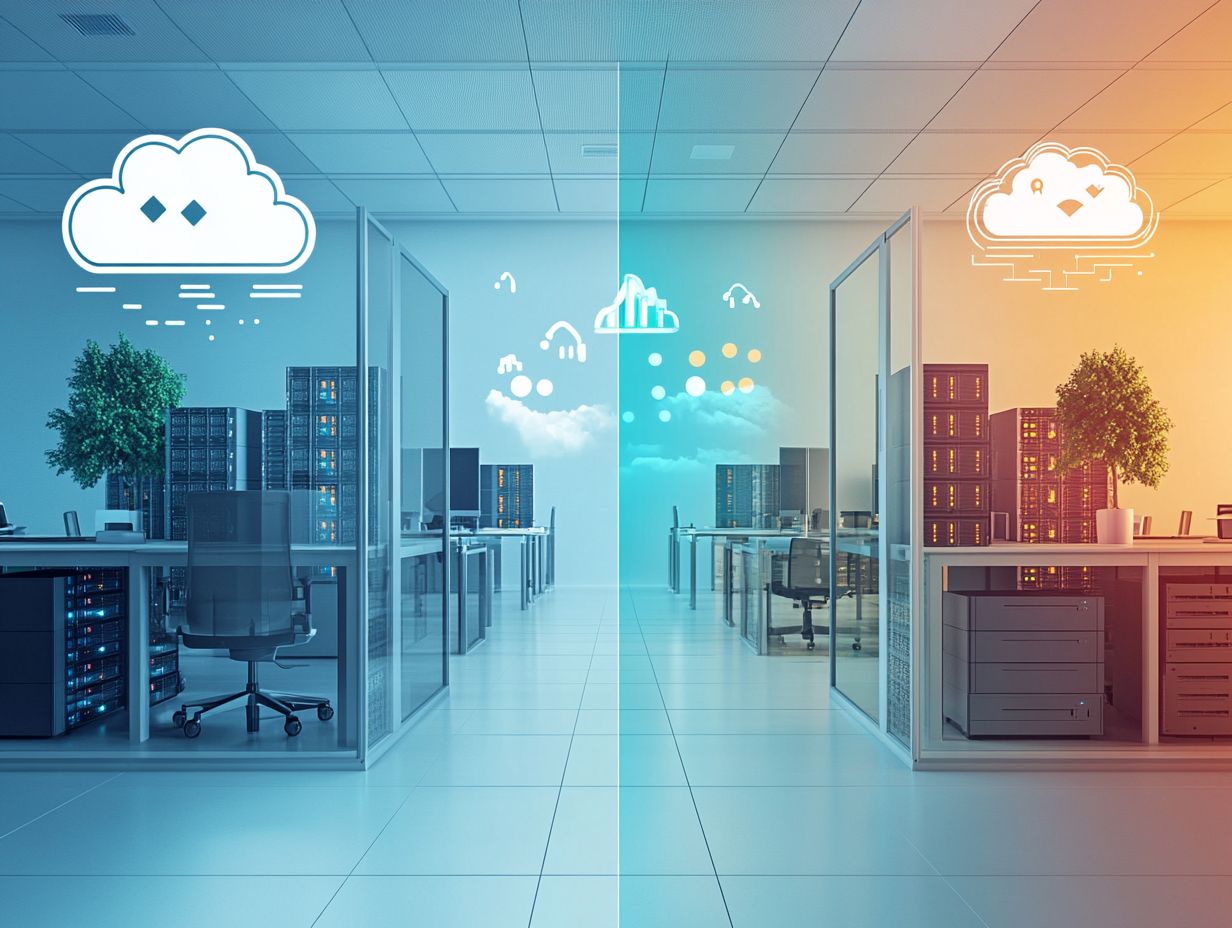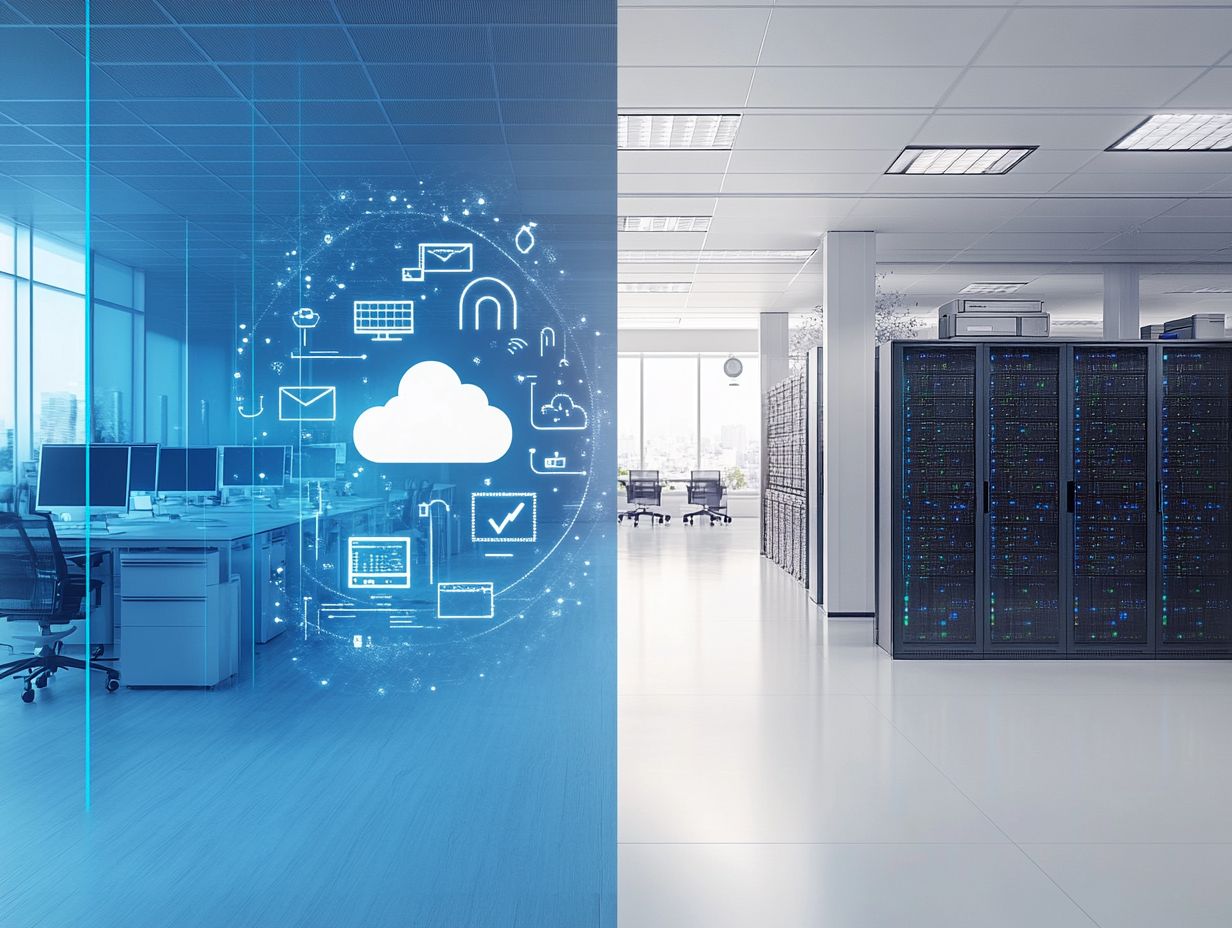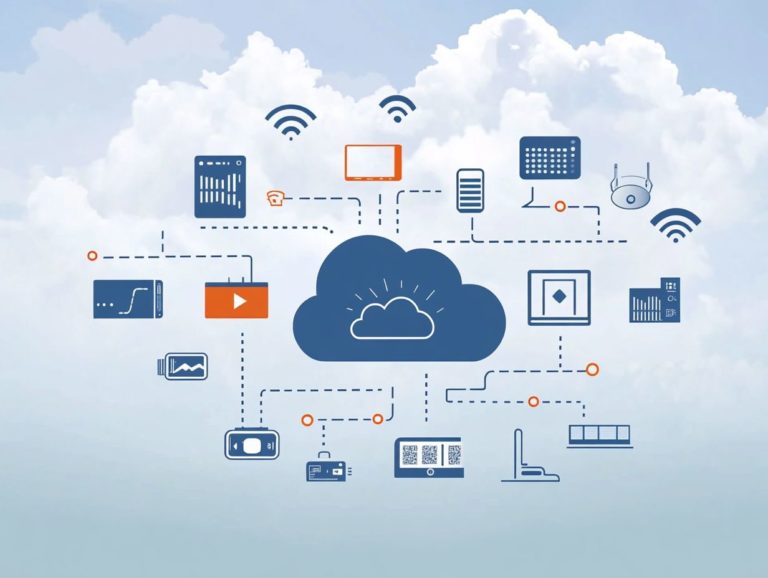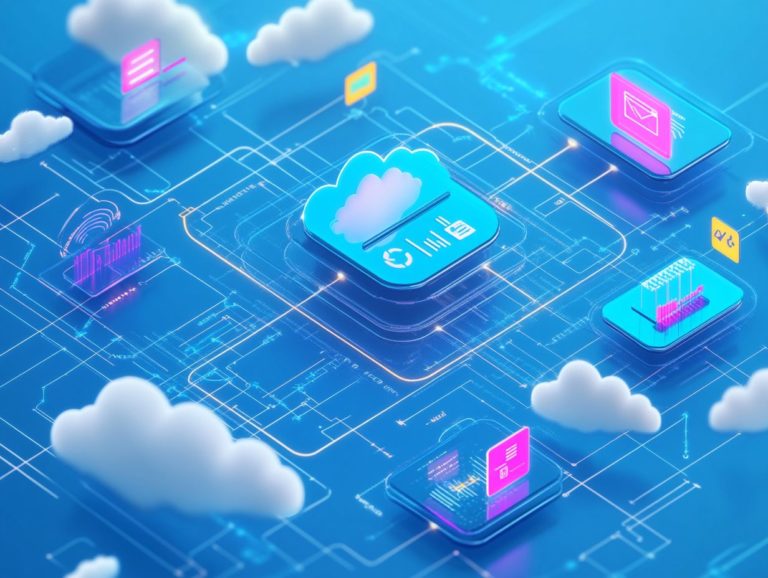Cloud Computing vs. Traditional IT
In today’s fast-paced tech landscape, grasping the key differences between cloud computing and traditional IT is crucial for you as a business leader aiming to optimize operations effectively.
This exploration highlights essential aspects such as infrastructure, cost, scalability, security, and flexibility, offering you a thorough comparison to inform your decisions.
Beyond the distinctions, you’ll discover the myriad benefits of cloud computing, including enhanced efficiency and collaboration. However, you’ll also consider potential challenges like data security and vendor lock-in.
Dive into this exciting journey and discover the future of IT!
Contents
- Key Takeaways:
- Defining the Terms
- Key Differences Between Cloud Computing and Traditional IT
- Benefits of Cloud Computing
- Challenges of Cloud Computing
- Frequently Asked Questions
- What s the main difference between cloud computing and traditional IT?
- What are the benefits of cloud computing compared to traditional IT?
- How s the security of cloud computing compare to traditional IT?
- Can you explain the concept of resource allocation in cloud computing and traditional IT?
- Is cloud computing more environmentally friendly than traditional IT?
- Which is More Cost-Effective: Cloud Computing or Traditional IT?
Key Takeaways:

1. Cloud computing offers a more efficient and cost-effective infrastructure compared to traditional IT, with the ability to easily scale up or down as needed.
2. The benefits of cloud computing include increased efficiency, accessibility, and collaboration, making it a popular choice for businesses of all sizes.
3. However, challenges such as data security, reliability, and vendor lock-in must be carefully considered before fully transitioning to cloud computing.
Defining the Terms
In today s fast-paced digital landscape, understanding the essential concepts of cloud computing and traditional computing is crucial for you as a business leader striving to enhance your IT infrastructure and streamline software delivery systems.
Cloud computing means using the internet to access services like storage and software, instead of having them directly on your computer. It enables you to manage resources in a flexible and affordable way, sidestepping hefty hardware investments.
In contrast, traditional computing relies on on-premises servers and dedicated hardware. This often results in increased capital and maintenance costs.
Both paradigms serve distinct user needs, making it imperative for you to understand their definitions and functionalities with clarity.
Key Differences Between Cloud Computing and Traditional IT
The key distinctions between cloud computing and traditional IT lie in scalability, cost-effectiveness, infrastructure management, and operational flexibility. For a deeper understanding, you can explore IaaS vs. traditional IT infrastructure, as each option is well-suited for different business models and user needs.
With cloud computing, you gain access to scalable solutions from providers like AWS and Microsoft Azure. This allows you to adjust resources in real-time without the maintenance costs and hardware investments that come with traditional IT setups.
Traditional computing typically involves fixed system resources. This setup can limit your ability to respond swiftly to evolving business requirements. Therefore, a careful evaluation of the cost implications and operational strategies is essential.
Infrastructure
The infrastructure of cloud computing stands in stark contrast to traditional computing. While the latter leans on physical data centers and hefty hardware investments, cloud computing harnesses virtual machines managed by cloud providers. This optimizes resource allocation and trims operational costs.
This transformation grants you access to an expansive array of resources with remarkable flexibility. It enables you to scale your operations up or down in response to demand without the hefty upfront costs tied to maintaining a physical space.
In the traditional model, adding capacity often demands significant capital expenditure and protracted procurement cycles. However, cloud solutions empower you to pay solely for the resources you actually use.
As a result, this approach not only enhances cost-effectiveness but also nurtures innovation. It allows you to swiftly launch new services and adapt to market fluctuations without being bogged down by infrastructure limitations.
Cost
Cost considerations are important when deciding between Cloud Computing and Traditional IT. Cloud Computing is often more cost-effective due to its pay-as-you-go pricing model.
This model reduces capital expenses. It allows for precise management of operational costs.
Flexibility enables organizations to scale resources according to demand. This means avoiding significant upfront investments associated with traditional IT.
Traditional IT requires hefty expenditures for hardware and software, alongside ongoing maintenance costs. These can become overwhelming over time.
Cloud Computing shifts costs from capital to operating expenses. This transition frees up resources for other critical areas.
The reduction of hidden costs, such as energy usage and space for servers, enhances the appeal of cloud solutions.
Companies increasingly recognize that this model promotes budget efficiency and fosters innovation.
Scalability

Scalability is a major advantage of cloud computing. It allows organizations to allocate resources dynamically based on demand.
In contrast, traditional IT often struggles with performance limits due to fixed infrastructure. Cloud solutions provide the flexibility to manage changing workloads effectively.
This allows for a quick response to increases in user activity. You can easily adjust resources in real-time, only paying for what you use.
Traditional IT demands significant investment in hardware, which can quickly become outdated. Many organizations are now adopting cloud technology to enhance efficiency and remain competitive.
Security
Cloud computing presents unique security challenges and solutions compared to traditional computing.
Cloud data security is strengthened by encryption and compliance protocols. This ensures that your data remains private and protected.
Traditional systems rely on on-premises controls, which can be vulnerable. Cloud environments use advanced encryption to secure data at rest and in transit.
Compliance with standards like GDPR enhances trust by promoting transparency. Traditional computing faces challenges such as limited scalability and complex updates.
Understanding these differences helps you make informed decisions about securing your data.
Flexibility
Flexibility is a standout feature of Cloud Computing. It offers user-friendliness and compatibility with various systems.
Cloud Computing allows you to adjust resources based on real-time needs. This ensures agility in today s fast-paced business world.
Unlike traditional systems, cloud solutions enable rapid deployment of applications. This minimizes downtime significantly.
Such capabilities allow for quick responses to market demands. This enhances operational efficiency and streamlines workflows.
Adopting this modern infrastructure improves user experience. It also fosters innovation by saving valuable time and resources.
Benefits of Cloud Computing
The benefits of Cloud Computing are vast and impactful. They significantly enhance efficiency, accessibility, and collaboration.
Cloud solutions streamline operations and reduce employee costs. They enable real-time collaboration, regardless of location.
These advantages boost productivity and meet needs effectively. Cloud Computing is a critical asset in today s digital landscape.
Efficiency
Efficiency stands as a key benefit of Cloud Computing, enabling you to significantly cut operational costs through the seamless integration of software applications.
By embracing these digital solutions, you can automate routine tasks and foster collaboration among your teams. This paves the way for quicker decision-making and enhanced productivity.
The on-demand access to data and applications that the cloud offers gives you the power to work from virtually anywhere, creating a more flexible work environment.
You can scale your resources according to current needs, minimizing waste and ensuring you only pay for what you actually use.
This adaptability makes your processes easier and helps your organization respond quickly to market changes, solidifying your competitive edge in an ever-evolving landscape.
Accessibility

Data accessibility reaches new heights in Cloud Computing, granting you remote access to digital assets through cloud services that allow you to work from virtually anywhere, at any time.
This innovative approach transforms traditional work environments, enabling seamless collaboration among teams, no matter where they are physically located.
You can take advantage of diverse platforms, ensuring that your important files and applications are just a click away, significantly enhancing efficiency and productivity.
The ability to integrate various tools and software within the cloud allows you to customize your workspace according to your specific needs.
In this interconnected world, accessible resources not only make your workflow easier but also promote a more flexible working culture, leading to greater job satisfaction and performance.
Collaboration
Collaboration in the realm of cloud computing has truly revolutionized the way you and your team interact.
With cloud solutions at your fingertips, you can share and modify digital assets in real-time, no matter where each team member is located.
This evolution gives you the power to work seamlessly with diverse groups, breaking down geographical barriers and significantly enhancing productivity.
By taking advantage of advanced features such as file synchronization and communication tools, you can stay connected and organized, ensuring that everyone is on the same page.
The importance of remote access cannot be overstated; it allows you to contribute from anywhere, whether you’re at home, in a caf , or on the go.
Integration with other applications streamlines your workflows, making cloud computing a critical asset for collaborative efforts across various industries.
Challenges of Cloud Computing
While Cloud Computing provides you with remarkable advantages, it also brings certain challenges to your attention.
Data security concerns, potential service disruptions, and a reliance on internet connectivity can all affect your user experience and the reliability of your operations.
It’s essential to navigate these complexities to fully harness the benefits of this technology.
Data Security
Data security presents a persistent challenge in Cloud Computing, compelling organizations like yours to implement stringent security protocols, including encryption, to mitigate the risks of data loss and unauthorized access.
To effectively navigate these challenges, it s essential for you to understand the various vulnerabilities that can impact cloud environments, such as misconfigured settings, inadequate access controls, and susceptibility to phishing attacks.
By adopting best practices, you can fortify your defenses, ensuring your digital assets remain secure.
Regularly auditing your cloud configurations, utilizing multi-factor authentication, and educating your employees about security awareness are just a few strategies that can significantly enhance your organization s overall security posture in this rapidly evolving technological landscape.
Don’t let data security slip through the cracks!
Reliability
Reliability in cloud computing can certainly raise eyebrows. Given the potential for service disruptions and technical issues, stemming from the inherent performance limitations of cloud infrastructures, this reality calls for a discerning approach when choosing your cloud provider.
Your business relies heavily on consistent access to data and applications. This makes reliability an essential pillar of operational success.
As you delve into this critical aspect, you may encounter challenges like data breaches, unexpected downtime, and scalability hurdles. To navigate these risks effectively, it s crucial for you to engage in careful research.
This involves researching the uptime records of potential providers. Utilizing multiple regions or zones for redundancy, and implementing robust backup solutions are also key.
Prioritizing reliability empowers you to safeguard your data. It also builds trust in your cloud services, ensuring seamless performance in delivering the critical functions that keep your business thriving.
Vendor Lock-in

Vendor lock-in poses a significant challenge in cloud computing. You may find yourself locked into specific cloud providers, leading to concerns about compatibility, data ownership, and your ability to switch services seamlessly.
Such dependency can impose substantial limitations on your business. It impacts both operational agility and long-term strategy.
As companies like yours increasingly migrate to cloud services, the risks associated with vendor lock-in become more pronounced. This situation prompts a search for effective mitigation strategies.
By grasping the importance of data ownership and thoroughly evaluating the flexibility offered by various platforms, you can devise tailored approaches that minimize potential drawbacks.
Embracing open standards, multi-cloud architectures, and robust governance practices gives you the power to maintain uninterrupted data access. This facilitates smoother transitions and reduces reliance on any single provider.
Frequently Asked Questions
What s the main difference between cloud computing and traditional IT?
The main difference lies in their approach to managing and delivering IT resources. Traditional IT involves purchasing and maintaining physical hardware and software, while cloud computing uses virtualized resources delivered over the internet.
What are the benefits of cloud computing compared to traditional IT?
Cloud computing offers several benefits over traditional IT. These include increased scalability, cost-effectiveness, and accessibility.
With cloud computing, resources can be scaled up or down as needed, often without additional costs. It also eliminates the need for large upfront investments in hardware and software, making it more cost-effective for businesses.
How s the security of cloud computing compare to traditional IT?
Security is a major concern for both cloud computing and traditional IT. However, cloud computing has significantly advanced security protocols and data protection measures in place, making it just as secure, if not more, than traditional IT.
Cloud providers invest heavily in security measures and regularly update their systems to protect against cyber threats.
Can you explain the concept of resource allocation in cloud computing and traditional IT?
In traditional IT, resource allocation involves purchasing and maintaining physical hardware and software to meet the organization’s computing needs. On the other hand, cloud computing uses virtualized resources that are allocated and managed by the provider.
This allows organizations to access the resources they need without worrying about hardware and software management or maintenance.
Is cloud computing more environmentally friendly than traditional IT?
Yes, cloud computing is more environmentally friendly compared to traditional IT. Traditional IT often results in a large carbon footprint due to each organization having its own physical hardware.
Cloud computing uses shared resources, reducing the need for individual organizations to maintain their own hardware, resulting in a smaller carbon footprint.
Explore your options today to enhance your business’s cloud strategy!
Which is More Cost-Effective: Cloud Computing or Traditional IT?
Cloud Computing is usually a smarter choice for long-term savings compared to Traditional IT. A comparison of hybrid cloud vs. traditional IT shows that Traditional IT requires a large initial cost for hardware and software, along with ongoing maintenance fees.
With Cloud Computing, you pay only for what you use. This flexible payment system makes it a budget-friendly option for many organizations.





